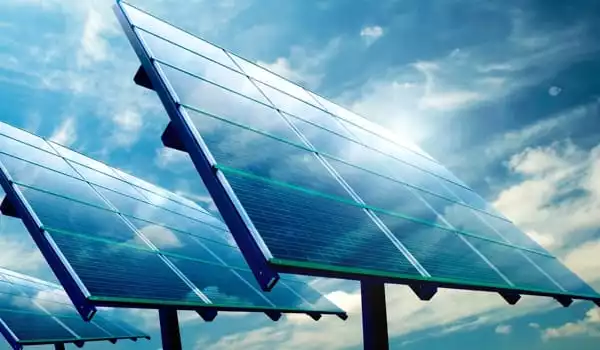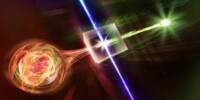Researchers at the University of Oklahoma, in collaboration with the National Renewable Energy Laboratory, the University of North Texas, the NASA Glenn Research Center, and several collaborators in the space power community, recently published a paper in the journal Joule that describes the optimal conditions for testing perovskite solar cells for space.
Perovskites are a type of material used in solar cells, which are devices that convert light into electrical energy. According to Ian Sellers, a physicist at the University of Oklahoma and co-author of the paper, perovskite solar cells are causing excitement in the photovoltaics community due to their rapidly increasing performance and high tolerance to radiation, which suggests they could be used to power space satellites and spacecraft.
Sellers, who is also the Ted S. Webb Presidential Professor in the Homer L. Dodge Department of Physics and Astronomy in the Dodge Family College of Arts and Sciences, and the associate director of the Oklahoma Photovoltaics Research Institute, has mentored multiple graduate students and a postdoctoral researcher in this field. The former postdoctoral researcher in Seller’s lab, Brandon Durant, is now a National Research Council Fellow residing at the U.S. Naval Research Laboratory and is one of the co-authors of the paper.
We discovered that the community as a whole is not appropriately testing them. Perovskites are thin films that are also quite soft, so if you apply the space protocols designed for standard solar cells, the interaction of high-energy particles is negligible, which means perovskites appeared radiation hard since they weren’t tested adequately, in our opinion.
Professor Sellers
“Perovskites are fascinating to a lot of people in the photovoltaics world because this new solar cell material can achieve high efficiencies and has done it rapidly and relatively inexpensively,” Sellers added. “But these materials also have significant issues in terms of stability and yield, particularly in atmospheric conditions — moisture, oxygen degrades this material, so it was interesting that despite these terrestrial instability issues, this system appeared radiation hard and appropriate for space.”
“The phrase ‘radiation hard’ is used by researchers to characterize how much damage occurs in an object or gadget when it is exposed to space radiation,” said Joseph Luther, a senior scientist on the National Renewable Energy Laboratory’s chemical materials and nanoscience team. “It’s intriguing, particularly with perovskite materials, because semiconductors are considered to be soft; however, radiation hardness simply implies that they can survive radiation-induced flaws without rapidly degrading performance.”
The team from OU, NREL, and the University of North Texas set out to tackle the question of how applicable typical space testing of solar cells is for perovskites.
“What we discovered is that perovskites are radiation hard, but not for the reasons many thought,” Sellers explained. “We discovered that the community as a whole is not appropriately testing them. Perovskites are thin films that are also quite soft, so if you apply the space protocols designed for standard solar cells, the interaction of high-energy particles is negligible, which means perovskites appeared radiation hard since they weren’t tested adequately, in our opinion.”

Durant collaborated with Bibhudutta Rout, an associate professor in the Department of Physics at UNT in Denton, Texas, to study the radiation hardness of solar cells under various situations or radiation exposure.
“We began doing these very focused radiation dependent studies by controllably stopping these particles in various areas of the solar cell,” Sellers explained. “So, instead of employing very high-energy particles, we used lower-energy particles, namely protons, because they are more detrimental to perovskites and are abundant in space, assaulting solar cells and other materials at low energies. When we tested this, we confirmed that perovskites are actually very radiation hard since they are soft and not particularly thick, allowing them to repair quickly when damaged.”
Sellers likens the effect to soaking in a tub of water. The water begins out calm. You can splash the water to create turmoil, but soon you stop, it will return to quiet.
“These perovskites are extremely near to being like a liquid, so when they’re injured, they self-heal,” he explained. “Perovskites, like a tub of water, will be disordered and injured in space, but will quickly settle or heal and return to normal. What we’ve done is developed a protocol, or a set of parameters under which perovskite cells must be evaluated before they are launched into space, to ensure that the global community tests these materials properly and consistently.”
Applications for this research bring up a world of possibilities. One area of scientific interest is the use of perovskites in permanent installations on the moon, specifically whether lightweight flexible perovskites could be carried into space folded up and successfully put there, or perhaps produced on the moon.
Similarly, future study could investigate the utility of perovskite solar cells for space missions to planets with high radiation levels, such as Jupiter, or for satellite missions in polar orbits.
“Mission requirements drive space validation of a new material,” said NASA Glenn Research engineer and co-author Lyndsey McMillon-Brown. “This work is critical because we are investigating the perovskite reaction to radiation that is most relevant to the applications NASA is most interested in.”
“By coming together and setting certain procedures on how these should be tested that the federal and commercial space communities have agreed on is a huge step forward that is pioneering for how perovskites could be implemented in space,” Sellers said.
















